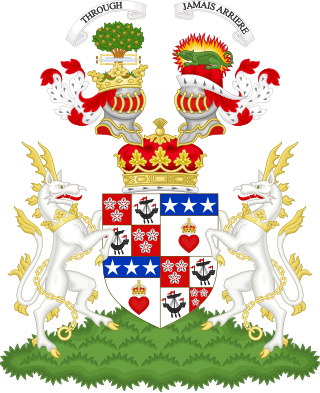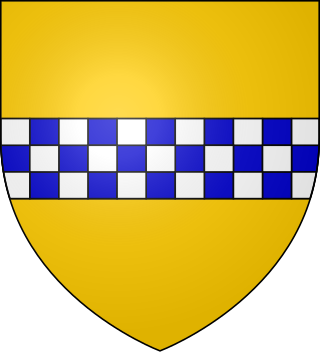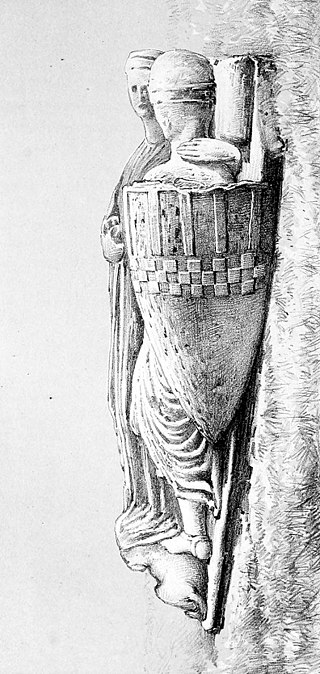Related Research Articles

Duke of Hamilton is a title in the Peerage of Scotland, created in April 1643. It is the senior dukedom in that peerage, and as such its holder is the premier peer of Scotland, as well as being head of both the House of Hamilton and the House of Douglas. The title, the town of Hamilton in Lanarkshire, and many places around the world are named after members of the Hamilton family. The ducal family's surname, originally "Hamilton", is now "Douglas-Hamilton". Since 1711, the dukedom has been held together with the Dukedom of Brandon in the Peerage of Great Britain, and the dukes since that time have been styled Duke of Hamilton and Brandon, along with several other subsidiary titles.

Alexander Stewart, known as Alexander of Dundonald, was a Scottish magnate who in 1241 succeeded his father as hereditary High Steward of Scotland.

The Lord High Constable is a hereditary, now ceremonial, office of Scotland. In the order of precedence of Scotland, the office traditionally ranks above all titles except those of the royal family. The Lord High Constable was, after the King of Scots, the supreme officer of the Scottish army. He also performed judicial functions as the chief judge of the High Court of Constabulary. From the late 13th Century the Court – presided over by the Lord High Constable or his deputies – was empowered to judge all cases of rioting, disorder, bloodshed and murder if such crimes occurred within four miles of the King, the King's Council, or the Parliament of Scotland. Following James VI's move to England, the jurisdiction of the Lord High Constable was defined in terms of the "resident place" appointed for the Council.
Patrick III, 7th Earl of Dunbar was lord of the feudal barony of Dunbar and its castle, which dominated East Lothian, and the most important military personage in the Scottish Borders.

Clan Hay is a Scottish clan of the Grampian region of Scotland that has played an important part in the history and politics of the country. Members of the clan are to be found in most parts of Scotland and in many other parts of the world. However, the North East of Scotland, i.e. Aberdeenshire (historic), Banffshire, Morayshire and Nairnshire Nairn (boundaries), is the heart of Hay country with other significant concentrations of Hays being found in Perthshire, especially around Perth, in the Scottish Borders, and in Shetland.

Robert V de Brus, 5th Lord of Annandale, was a feudal lord, justice and constable of Scotland and England, a regent of Scotland, and a competitor for the Scottish throne in 1290/92 in the Great Cause. He is commonly known as "Robert the Competitor". His grandson Robert the Bruce eventually became King of Scots.

William Comyn was Lord of Badenoch and Earl of Buchan. He was one of the seven children of Richard Comyn, Justiciar of Lothian, and Hextilda of Tynedale. He was born in Scotland, in Altyre, Moray in 1163 and died in Buchan in 1233 where he is buried in Deer Abbey.

Alexander Comyn, 2nd Earl of Buchan was a Scoto-Norman magnate who was one of the most important figures in the 13th century Kingdom of Scotland. He was the son of William Comyn, Lord of Badenoch, and Marjory, Countess of Buchan, the heiress of the last native Scottish Mormaer of Buchan, Fergus. He was the chief counsellor of Alexander III, King of Alba (Scotland) for the entire period of the king's majority and as Scotland's leading magnate, played a key role in safeguarding the independence of the Scottish monarchy. During his long career, Alexander Comyn was Justiciar of Scotia (1258–1289), Constable of Scotland (1275–1289), Sheriff of Wigtown (1263–1266), Sheriff of Dingwall (1264–1266), Baillie of Inverie and finally, Guardian of Scotland (1286–1289) during the first interregnum following the death of Alexander III. In 1284 he joined with other Scottish noblemen who acknowledged Margaret of Norway as the heiress to King Alexander. He died sometime after 10 July 1289.
John Comyn (Cumyn) was Lord of Badenoch in Scotland. He was Justiciar of Galloway in 1258. He held lands in Nithsdale and Tynedale.
Patrick II (1185–1249), called "6th Earl of Dunbar", was a 13th-century Anglo-Scottish noble, and one of the leading figures during the reign of King Alexander II of Scotland.
William, Lord of Douglas, known as 'Longleg', was a Scottish nobleman. He was the son of Archibald I, Lord of Douglas.

Walter Bailloch, also known as Walter Bailloch Stewart, was distinguished by the sobriquet Bailloch or Balloch, a Gaelic nickname roughly translated as "the freckled". He was the Earl of Menteith jure uxoris.
Christina Stewart Douglas, Countess of Buchan, also known as Christian, was a Scottish noblewoman, the suo jure Countess of Buchan.

Elizabeth Hay, Countess of Erroll was an illegitimate daughter of King William IV of the United Kingdom and Dorothea Jordan. She married William Hay, 18th Earl of Erroll, and became Countess of Erroll on 4 December 1820 at age 19. Due to Hay's parentage, William Hay became Lord Steward of the Household. Elizabeth and William Hay married at St George's, Hanover Square. Hay is pictured in a FitzClarence family portrait in House of Dun, and kept a stone thrown at her father William IV and the gloves he wore on opening his first Parliament as mementos.
Alexander Gordon, 3rd Earl of Huntly was a Scottish nobleman. He was a member of Parliament, a member of the Privy Council, a regent and Lieutenant of the kingdom.

Clan Cumming, historically known as Clan Comyn, is a Scottish clan from the central Highlands that played a major role in the history of 13th-century Scotland and in the Wars of Scottish Independence. The Clan Comyn was once the most powerful family in 13th-century Scotland, until they were defeated in civil war by their rival to the Scottish throne, Robert the Bruce.
William Ruthven, 1st Lord Ruthven was a Scottish nobleman and founder of the noble lines of the Ruthven family.
Gilbert de Umfraville was a 13th-century English baron. Gilbert was the eldest son of Richard de Umfraville, Lord of Redesdale. He succeeded his father as Lord of Redesdale and Baron Prudhoe from November 1226 at his seat of Prudhoe Castle. He also had lands at Otterburn.

William Hay, 1st Earl of Erroll was a Scottish peer. He was the first Earl of Erroll and the second Lord Hay of Erroll.
Sir William Galbraith, 4th of that Ilk, Lord of Buthernock and Kincaid, was a Scottish noble. He was the eldest son of Arthur Galbraith.
References
- Balfour, Paul James (1906). The Scots Peerage : founded on Wood's edition of Sir Robert Douglas's Peerage of Scotland; containing an historical and genealogical account of the nobility of that kingdom. Vol. 3. Edinburgh: David Douglas.
- Burke, John (1835). A Genealogical and Heraldic History of the Commoners of Great Britain and Ireland, enjoying territorial possessions or high official rank, but uninvested with heritable honours. Vol. 1. London: Henry Colburn.